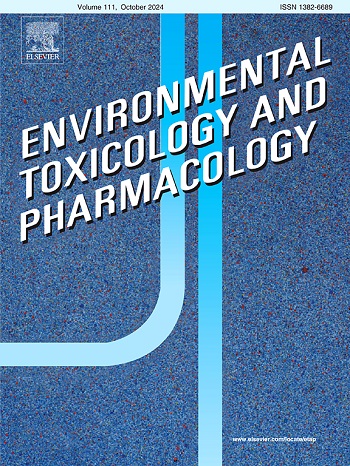全反式维甲酸诱发腭裂的机制可能与新型ENSMUST00000159153-miR-137-5p-Wnt7a和ENSMUST000000236086-miR-34b-3p-EphA10/TRPM2 ceRNA串扰有关。
IF 4.2
3区 环境科学与生态学
Q2 ENVIRONMENTAL SCIENCES
引用次数: 0
摘要
腭裂是最常见的先天性疾病。腭裂是由一种叫做全反式维甲酸(atRA)的外源性化学物质引起的。为了间接控制基因表达,长链非编码RNA (lncRNAs)扮演了竞争性内源性RNA (ceRNA)海绵的角色。它在腭裂中的确切作用方式尚未确定。本研究的目的是确定lncRNAs和miRNAs是否在腭裂形成过程中调控腭融合基因,为腭裂靶基因治疗提供可能的途径。在这项工作中,我们利用atRA建立了腭裂模型,进行RNA测序(RNA-seq)来鉴定atRA治疗组与对照组之间的差异基因,并基于预测的ceRNA构建了lncRNA-miRNA-mRNA ceRNA网络。结果用实时定量聚合酶链反应(qRT-PCR)证实。结果显示,ENSMUST00000159153-miR-137-5p-Wnt7a和ENSMUST000000236086-miR-34b-3p-EphA10/TRPM2可能是atra诱发腭裂的主要原因。本文章由计算机程序翻译,如有差异,请以英文原文为准。
The mechanism of all-trans retinoic acid-induced cleft palate may be related to the novel ENSMUST00000159153-miR-137–5p-Wnt7a and ENSMUST000000236086-miR-34b-3p-EphA10/TRPM2 ceRNA crosstalk
Cleft palate is the most prevalent congenital condition. Cleft palate is brought on by an exogenous chemical called all-trans retinoic acid (atRA). In order to indirectly control gene expression, long chain non-coding RNAs (lncRNAs) act as competitive endogenous RNA (ceRNA) sponges. Its exact mode of action in cleft palate has not yet been determined. The purpose of this study was to determine whether lncRNAs and miRNAs regulated palatal fusion genes during the formation of cleft palate and to offer a possible course for cleft palate target gene therapy. In this work, we created a cleft palate model using atRA, conducted RNA sequencing (RNA-seq) to identify the genes that differed between the atRA-treated group and the control group, and built the lncRNA-miRNA-mRNA ceRNA network based on the projected ceRNA. The results were confirmed using a quantitative real-time polymerase chain reaction (qRT-PCR). ENSMUST00000159153-miR-137–5p-Wnt7a and ENSMUST000000236086-miR-34b-3p-EphA10/TRPM2 may be the main causes of atRA-induced cleft palate, according to the results.
求助全文
通过发布文献求助,成功后即可免费获取论文全文。
去求助
来源期刊
CiteScore
7.00
自引率
4.70%
发文量
185
审稿时长
34 days
期刊介绍:
Environmental Toxicology and Pharmacology publishes the results of studies concerning toxic and pharmacological effects of (human and veterinary) drugs and of environmental contaminants in animals and man.
Areas of special interest are: molecular mechanisms of toxicity, biotransformation and toxicokinetics (including toxicokinetic modelling), molecular, biochemical and physiological mechanisms explaining differences in sensitivity between species and individuals, the characterisation of pathophysiological models and mechanisms involved in the development of effects and the identification of biological markers that can be used to study exposure and effects in man and animals.
In addition to full length papers, short communications, full-length reviews and mini-reviews, Environmental Toxicology and Pharmacology will publish in depth assessments of special problem areas. The latter publications may exceed the length of a full length paper three to fourfold. A basic requirement is that the assessments are made under the auspices of international groups of leading experts in the fields concerned. The information examined may either consist of data that were already published, or of new data that were obtained within the framework of collaborative research programmes. Provision is also made for the acceptance of minireviews on (classes of) compounds, toxicities or mechanisms, debating recent advances in rapidly developing fields that fall within the scope of the journal.

 求助内容:
求助内容: 应助结果提醒方式:
应助结果提醒方式:


